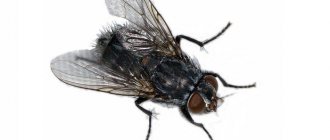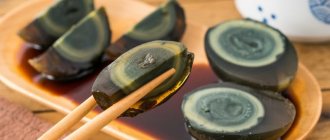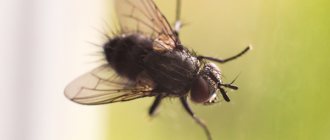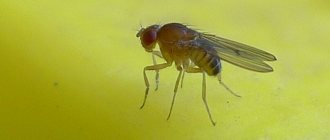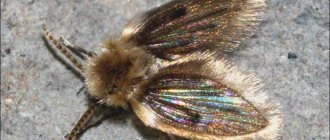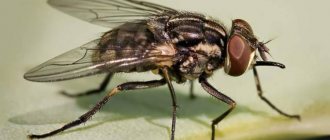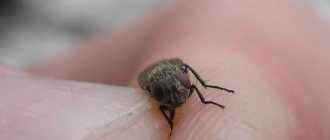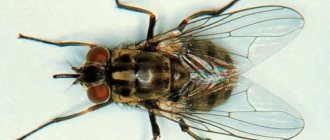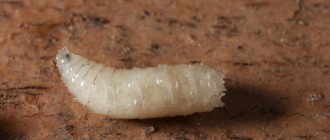Flies constantly annoy humans during the warm season. And all measures to combat them generally give a short-term effect, since these insects are able to penetrate into an apartment or house without much difficulty.
The main function of flies is reproduction. Therefore, females lay eggs in any suitable places and after some time larvae emerge from them. And since maggots feed on many foods that humans eat, the likelihood of them being swallowed is quite high. Therefore, it is worth understanding what this means for human health.
Where do flies lay their eggs?
Females initially worry about future offspring. Therefore, flies lay eggs where the larvae can fully feed and develop immediately after birth, since without food they die after 2 days.
In nature, this is usually organic waste of a liquid consistency, since the mouthparts of maggots are not designed for solid food. At home, the fly tries to lay eggs on human food.
Receptors on the legs, which act as an organ of touch, help the insect find the optimal place for its offspring. Then the fly uses its proboscis to check the consistency and taste of the product, and only after that it lays eggs.
Contaminated Meat
Suitable for this:
- meat;
- fish;
- fruits;
- vegetables;
- offal;
- cottage cheese;
- cheese.
Ready-made meals based on cereals can also serve as food for offspring. In order for an insect to lay eggs, it is quite enough to leave food on the table for a short time during the warm period of the year.
Urogenital myiasis
After the larvae penetrate the human urethra, severe pain begins in the urinary canal, often with delayed urination. For treatment, the urethra is washed.
This disease can be caused by any type of dipteran insect, but tourists who go on safari to Africa especially often suffer from it. The Congo region is home to the mangrove fly, which lays eggs on damp vertical surfaces.
The local population knows about this feature of the insect and dries clothes by laying them out horizontally. Tourists who do not understand the reason for this custom hang their laundry on clotheslines. And they get cavitary genitourinary myiasis.
Types of larvae
There are about 3.5 thousand species of flies in nature, but only a few of them penetrate into a person’s home. Finding favorable conditions here, they lay eggs, from which larvae subsequently emerge.
Maggot
In addition to the larvae of ordinary houseflies, the following species can be found in an apartment:
- Maggot . The length of the insect reaches 15 mm. This species is the offspring of the blue carrion fly. Maggots can appear in meat and fish.
- Gozzer . This is the larva of the black-headed blue fly. Characterized by rapid pupation. The size of the insect at the last stage of development reaches 20 mm.
- Gordini . The maggot of a gray blowfly, the size of which reaches 20-25 mm. The larva quickly pupates.
- Pinka . This species is the offspring of the green blowfly. The body length of the larvae does not exceed 10 mm.
- FIFA . Lucilia fly maggot. Belongs to the category of frost-resistant species. The length of the larva does not exceed 12 mm.
How long does a fly live: common fly, midges, in an apartment, on the street
How long do houseflies and their outdoor relatives live?
Let's compare the life expectancy of different species of these insects. The average lifespan of a fly is short - only 2-4 weeks, sometimes a little more if the living conditions are as favorable as possible. But during its short life, this insect manages to breed several generations of offspring, so sometimes it seems that the same individuals live for an unimaginably long time.
Musca domestica, house fly
Flying insects of this species live only where a person lives, or in maximum proximity to him. They are practically never found in the wild. On the territory of Russia there are 2 subspecies of house flies - common and southern.
The development speed and lifespan of insects is very dependent on the ambient temperature. The range of 23-25 °C is optimal for it; at this temperature, an adult can live up to 8-9 weeks, while the standard life expectancy is only 3 weeks.
The house fly goes through several stages of development:
- Egg. Develops from 8 to 50 hours.
- Larva (maggot). She molts three times before becoming a pupa. This takes her from 3 to 25 days.
- Doll. The insect goes through this stage in about 3-6 days.
- Imago (adult insect). Lives from 2 weeks to a month, sometimes up to 2 months. 36 hours after the transition from the pupal stage to the adult, the fly is capable of reproduction. During her life she lays about 2000 eggs.
In addition, when the temperature drops, adults, larvae and pupae are able to hibernate, additionally living in sleep for several more months. Under favorable conditions, insects of this species reproduce continuously throughout the year.
Autumn burners
Autumn flies, like Musca domestica, belong to synanthropic species (coexist with humans), although there have been cases of their reproduction in places where wild animals gather.
In appearance and in their lifestyle, zhigalkas are very similar to their indoor relatives. The difference is that live flies can bite humans, while houseflies are not capable of biting through human skin.
The population of autumn firebirds reaches its peak in late summer - early autumn. The lifespan of an adult autumn fly is 3-8 weeks, but flies of this species are also capable of hibernating.
Flesh and carrion flies
Flesh flies and carrion flies can also be easily confused with a housefly; they look similar in appearance, but the housefly is smaller in size than its wild relatives. The life of adult blow flies is very short - usually only 5-7 days. Their carrion relatives live up to 3 weeks.
Dung fly (Scathophagidae)
This insect lays larvae in manure, so it can often be found in barns. She rarely flies into an apartment and by pure chance, since there is nothing attractive for her in a person’s home. Lifespan is about 30 days.
Drosophila
Drosophila flies (fruit flies, wine flies) number about 1,500 species, among which there are wild and synanthropic flies. These small harmless insects often settle in apartments and gardens. Life expectancy is 3-4 weeks (not counting the time spent on the development of eggs, larvae and pupa).
Sciarids - flower flies
Sciarids, also known as detritus gnats or fruit gnats. Sciarides are often confused with fruit flies due to their small size. Owners of greenhouses and indoor plants often encounter them in everyday life. Adult sciarids live for several weeks, and development from egg to adult takes approximately the same amount of time.
What do they look like?
Regardless of the type of fly, their eggs and larvae are similar in many ways. The difference can only be in the size and shades of color of the larvae. When magnified, a fly egg resembles the color and shape of a grain of rice. Its size is about 1-1.5 mm.
The fly larva is born approximately 2 mm in size. For each molt, it doubles in size and at the pre-pupation stage elongates to its maximum size. The weight of an adult maggot is 22-27 g, depending on the species.
The larvae can be gray, beige or yellowish in color. They have a segmented elongated body. Insects move due to false legs in the form of convex growths, which are located on the sides of the body. The insect's body consists of a head capsule, thoracic and abdominal regions. In the front part there is a mouthparts with retractable hooks. The larval chest consists of 3 segments, and the remaining 10 belong to the abdominal section.
The prepupa of a fly initially has the same color as the larva. But as she gets older, her skin hardens and darkens. The insect pupa has the shape of a barrel with pronounced transverse circular notches. It is dark brown in color.
Lifespan
As we already understood from the previous chapters of our review, the total lifespan of a fly can be 10-30 days. Having summed up all the stages of the life cycle during which the development of a fly occurs from birth as an egg to the death of an adult winged individual, we arrive at exactly this general period.
What factors influence the lifespan of a buzzing parasite? First of all, the temperature regime of its habitat. The insect can live in conditions from 10 to 40 degrees, but the optimal range is 18-25 degrees.
The life of a fly can last much longer than several weeks, especially if the insect managed to survive the winter period. Some particularly lucky individuals can live for 2 months, but this is still largely an exception.
What happens if you eat a fly larva?
In most cases, if you eat a fly larva, nothing bad happens. However, another development of events is also possible, which will cause serious health problems.
Myases
This parasitic disease can be caused by the larvae of the gray blowfly and wohlfarth fly. This occurs against the background of a weakened immune system and disruption of the digestive system. In this case, if a person eats a larva, it is not processed in the stomach, but enters the systemic bloodstream and any internal organ. As a result, this leads to the development of an inflammatory process and can cause weakness, fever and other health complications.
Miaz
Intestinal myiases
This type of disease develops when larvae deposited by a fly enter the human intestine. This causes inflammation of the organ mucosa, accompanied by pain in the abdomen, diarrhea, and vomiting.
The disease can develop if you swallow the larva of a housefly, housefly, blue blowfly, or cheese fly. This occurs with reduced acidity of gastric juice and aerophagia.
In most cases, the larvae die in the human body and come out with vomiting and excrement; in rare cases, surgical intervention is required.
Intestinal myiasis
Salmonella
Swallowed fly larvae can be carriers of salmonellosis. This infectious disease is accompanied by a sharp increase in body temperature, diarrhea, fever, and loose stools.
In most cases, the disease does not require special treatment and goes away on its own with diet and drinking plenty of fluids.
Salmonella
Consequences
If a person accidentally swallows an adult fly or eggs of a fly, then usually nothing bad happens. Insects consist of protein and chitinous shell, which are easily broken down by gastric juice or excreted naturally.
Some people have an individual reaction in their digestive tract to fly eggs. The painful condition manifests itself in the form of:
- stomach ache;
- nausea;
- vomiting;
- stomach upsets.
If symptoms persist for more than 2–3 hours, and health worsens, then call a doctor as soon as possible for the victim.
The real danger to people is the larvae of gray blowflies, which cause myiases - parasitic diseases of the skin, intestines, stomach, respiratory system, vision, and hearing. However, such a lesion is typical for countries in Africa and South America, where this type of fly lives.
Under normal conditions, even if you swallow a fly, its eggs or larvae, it will not have any serious consequences for the body.
Fighting fly larvae
To prevent the appearance of larvae in the house, you need to keep it clean so that flies cannot lay eggs. It is necessary to take out the trash in a timely manner, hide food in the refrigerator, put away pet food and equip windows with protective nets.
Maintain cleanliness
It is also necessary to take into account that for the development of maggots, a temperature within +12...300C is required. If you are not sure of the quality of the products, you need to heat treat them. The larvae die at temperatures above +500C.
Why do cats hunt insects?
Cats love to chase insects. This is due to the fact that pets exhibit an innate hunter instinct. Even if an animal lives a domestic life and eats well, it does not miss the chance to have a race with insects.
It is impossible to call your pet while hunting. He does not respond to his favorite toys or screaming. This applies to even the laziest cats.
Important: if a cat catches a fly, it will definitely eat it. Thus, the pet demonstrates its strength, agility and hunting skills
Many pet owners get scared when their pet eats a pest. Before you run to the vet, you need to understand what the danger is and whether the problem can be eliminated on your own.
Do people intentionally eat fly larvae?
Sardinian cheese Katzumarza has a unique pungent taste. This is achieved due to the presence of fly larvae in its composition. According to the technological process, at an early stage of its production, it is necessary to remove the top crust to attract the attention of flies. Penetrating inside the cheese, they lay eggs, and the larvae live and feed in it for several months. It is the excrement of maggots that gives the final product its unique taste.
However, the European Community for Food Safety has now banned the sale of Katsumartsa cheese, citing a high risk to human health.
Plants
There are many plants in nature whose smells repel flies. Moreover, in most cases, these are herbs that a person grows in his garden and eats, but their aroma cannot be tolerated by winged insects.
The aromatic herb is also crushed and placed in cotton bags, and spice sachets are made. All this drives away the flies. Let's take a closer look at the most common plants.
Basil
Basil grows almost everywhere and is unpretentious to watering. Most people grow this fragrant plant for pesto sauce and also to use it in salads with fresh cheese and tomatoes. But few people know that basil is one of the most effective means of fighting flies.
Insects fly around this plant, so in a country house or in a private house it is enough to plant it near the door, and in an apartment, grow basil in pots on the windowsill. Thus, in the summer you will receive good protection not only from flies, but also from mosquitoes. At a picnic, a bunch of this plant will also serve you well.
Tomatoes
Flies do not like tomato fruits so much as the tops and leaves of this vegetable. Knowledgeable people grow tomatoes even in apartments, choosing varieties with miniature fruits and spreading bushes, placing seedlings in boxes on the balcony or in pots on window sills.
Young leaves and stems of tomato bushes can be laid out on the surface of the refrigerator or wall furniture.
Laurel
Bay leaves can not only season chicken broth or roasts, but also repel flies. If you do not grow it in your garden, on the balcony in a pot, then use a dry laurel leaf. It will disperse not only flies, but also other insects, and even mice.
You can break the bay leaf, add a small amount of water and place such bowls in areas occupied by flies. You will get a pleasant air flavor, and also get rid of flies - this smell has a negative effect on them.
Be sure to lay out the bay leaves (it’s better to break them at least in half) near the trash can or wash the floor with a strong bay decoction. It can also be used to wipe down work surfaces in the kitchen, where flies first go in search of food.
Sagebrush
Flies are also afraid of the smell of wormwood. The branches of this plant have the same effect as the branches of a tomato. Some people stock up on wormwood to treat ulcers, burn wounds, gastritis and bronchitis. When dried, the herb does not lose its properties and emits the same strong aroma as fresh wormwood.
This is a good repeller for flies; in addition, mosquitoes and other midges are not found near wormwood.
Mint
Almost everyone knows the smell of mint; different varieties of this plant grow everywhere. By the way, have you noticed that where mint grows there are fewer mosquitoes, ants, flies, and fleas? Dry it and place it in cabinets to preserve food longer.
And in an open space, the mint aroma will repel annoying flies and mosquitoes. A good example is when peppermint grows right next to the veranda - in this case, you can safely open the windows, the protection against insects will work.
Rosemary
Gourmets are familiar with the herb rosemary. It is also used in medicine, and planting it near the house will effectively “work” against flies and mosquitoes. Please note that cats do not like rosemary essential oil, so use this moment to preserve your furniture: place dry twigs on the sofa and provide yourself with peace.
Other plants that will protect against winged insects include lavender, tansy, elderberry, bird cherry and others. Plants that emit strong aromas can be planted around the perimeter of the garden plot, near the entrance to the house, and for those who live in a high-rise building - in pots on the windowsill, on balconies.
Do cockroaches grow in household appliances?
Good afternoon. Cockroaches have taken up residence in my irreplaceable multicooker. I tried everything I could to get them out, but to no avail. I would like to hear expert advice on how to quickly get rid of such a neighborhood?
Expert's answer:
Can cockroaches live in household appliances? The answer is yes. Such situations occur frequently. Whiskered parasites are attracted to a comfortable, warm climate and high humidity. Most often, they crawl into the indoor unit with electronics and begin to multiply there.
How to kill cockroaches in a slow cooker?
There are many different drugs to combat “mustachioed neighbors.” If your goal is to drive them out of a household appliance, and not to remove them, then you can use all kinds of repellers, the use of which will solve only part of the problem. The cockroaches will leave the slow cooker and move to another place.
To remove insects and forget about them, you will need to disassemble the device and treat the accumulation areas with a special product. After all parasites have been destroyed, the structural elements must be thoroughly cleaned with a disinfectant, dried and put back together.
Are there traditional methods?
For those who do not want to use chemicals, but want to get rid of cockroaches in a slow cooker, they can use the simplest method - freezing and then cleaning the equipment. In winter, you can put the multicooker in the cold for several days. In summer you will have to use the freezer.
Why is it dangerous?
Phases of fly development.
Well, let’s even start with the fact that the bite of a burner is very painful. It is not without reason that this type of fly received such a name. At the moment of the bite, the person feels a fairly strong burning pain.
This is not at all a harmless mosquito bite that appears only some time later, no. The zhigalka acts, let's say, much rougher. A mosquito next to a fly is simply a jeweler in his field.
In addition to, in fact, a painful puncture with the proboscis, the burner fly also introduces saliva that irritates the affected area, which has an inflammatory effect at the site of the bite.
Flies.
In addition to pain and inflammation at the puncture site, these dipterous pests, like all flies, are malicious carriers of all sorts of dangerous diseases.
One can only imagine how many times this pest used its piercing weapon during the season, and how dangerous the bite of such a carrier of all sorts of nasty things could be for humans.
Among the diseases that a bite from such a bloodsucker can give us, we highlight the following, namely:
- typhus;
- sepsis;
- anthrax;
- tuberculosis;
- dysentery;
- polio;
- trypanosomiasis.
And this is not the entire list of “free services” that this pest can provide to us voluntarily and completely free of charge.
Benefits and harms
The benefits or harms of hoverflies cannot be judged unambiguously. Much depends on the specific species living near gardening farms or agricultural fields.
By feeding on insect pests such as aphids, the larvae of these flies preserve fruit trees and shrubs. And in mountainous areas where the number of bees is reduced, adult hoverflies are irreplaceable helpers for humans. By pollinating flowering cultivated plants, they increase their productivity.
But at the same time, some species are malicious pests of lily crops. By eating onions, garlic and damaging the bulbs of tulips, daffodils, hyacinth, the larvae create big problems for gardeners and flower growers. Damaged plants slow down and wither. And bulbs intended for storage quickly rot.
Several maggot recipes
08/11/2015 Author: Buerakov V.S.
The Russian name for the fly larva – maggot – has a common root with the word “opara”, which is known to all housewives. After kneading the dough and leaving it warm, after a couple of hours it will begin to significantly increase in volume, swell, bubble and lift the lid of the dish. The same is true for maggots – they grow in warm conditions, as if by leaps and bounds. In 5 days the larva increases in mass by 250 times!
Decaying organic matter, animal carcasses and food waste attract the well-known houseflies, blue blowflies and green flies. These buzzing creatures are especially attracted to meat scraps or fish. You've probably noticed many times: leaving a caught fish on the shore for a couple of minutes, flies immediately flock to it. And if your prey starts to smell a little...
These buzzing swarms sense prey, probably kilometers away. In search of secluded places, the flies carefully examine the find. Typically, clutches of eggs can be found under the gills, in the eyes or in the mouth of a dead fish. From such places, the born larvae make their way inside and begin to eat away at the fish.
Different types of flies can lay eggs in the same fish, so it often happens that some maggots are larger and some are smaller.
In home breeding, fish are only the starting food. Having left behind its scales and skeleton, the larvae look for new food. You can offer them old, missing cottage cheese or barley porridge with milk. However, there is one unpleasant property: with their secretions, the larvae accelerate the process of rotting of their food. In a tightly sealed vessel, the substrate will quickly turn into a disgusting bubbling mass filled with suffocated larvae. Yes, but when the lid is open there will be a smell, which is also not the best. As with anything, you just need to be patient.
It is better to make the lowest layer in the maggot container from sawdust. This will keep our “incubator” at least somewhat clean. Being warm, the larvae will gain mass in 5-6 days and, wanting to turn into pupae, will go into the sawdust, to the bottom, and from here it is not difficult to get them out. Maggot prepared in this way is considered clean. In addition, you can further clean the bait: before going fishing, put the maggots in a container with dry semolina. The larvae in it will be cleaned with a double guarantee.
Slightly spoiled meat and various offal - lung, liver - are no less tempting for flies. A lazy fisherman, the owner of a plot of 6 acres, can build his own “incubator” and breed maggots in it. Its structure and design are nothing complicated. A piece of spoiled meat should be placed in a tin container (tank, bucket), covered on top and left in the shade (not in the sun - the rays of the sun kill maggots). Flies enter through the gaps in the container and lay eggs on the meat. Soon, larvae will form and eat various passages in the bait. The maggot senses when it needs to stop eating, and, throwing away a tasty morsel, buries itself in the sawdust. If the bottom of our incubator is made hinged, it will be very convenient for sifting sawdust through a sieve with large cells. One half-kilogram piece of meat is enough to get bait for several fishing trips.
Many fishermen also advise splitting the mosol (a large hollow bone) and lightly covering it with earth. This way you can get several dozen larvae. But we don’t need such “microproduction”. You can also get maggots from carrion - a dead bird or animal, but this is a last resort.
Storing maggots has its own differences from storing bloodworms. The fly larva is more resilient - this is definitely a plus. However, she quickly turns into a fly - this is a minus. Often on a hot day you can notice how maggots become numb, their covers harden, and the newly nimble larvae turn into dark, motionless pupae. Fish, as a rule, inactively bite on them. And if the jar with bait is left warm for a couple of days, it will soon be filled with newborn flies. And what to do with them then? As a last resort, you can try fishing with a fly, but only the most superficial, the hungriest fish will be tempted by such bait.
A frost-sorcerer comes to the aid of the thrifty fisherman, in other words, a household refrigerator. You can store maggots in it from a week to two months, after sprinkling the bait with flour or bran. At cold temperatures (near zero), the larvae fall into a state of anabiosis, and all their life processes are suspended. Maggots hatched in late summer or early autumn will last the longest. There have been cases when fishermen in central Russia, even in October, managed to obtain clutches of eggs from belated flies. During this period, the larvae seem to be ready for the upcoming winter and feel that they will not be able to turn into a fly until next spring.
During the winter, maggots can be stored in a kind of “bunker” located outside. A small diameter pipe is sealed on one side and driven into the ground a meter and a half below the freezing horizon. Then they make a cardboard or tin cylinder of slightly smaller diameter, foam capping and place the larvae in such a container. And in the spring, maggots removed from it and placed in warmth quickly return to life, showing their readiness to go fishing right now.
Five sophisticated recipes for making maggots
When it is not possible to keep the larvae alive, they are frozen in the freezer. Before fishing, you need to take them out and thaw. This bait retains its basic qualities, and the fish take it with pleasure.
It is believed that English fishermen began pickling larvae in vinegar. They claim that this way the bait will stay on the hook more securely. After marinating the maggots, they are additionally lightly baked in the oven on a baking sheet. “We don’t know how it is in London, we haven’t been,” but live maggot is already considered a reliable bait: it can withstand 5-6 bites, stays on the hook until the fish tears it to pieces.
Maggots with egg
This recipe came to us from Polish fishermen. If you let the larvae eat the yolk of a half-boiled egg before going fishing, they will acquire a yellow color and a specific taste that attracts fish.
In order to obtain such maggots, the larvae must be bathed in milk, adding beet juice or red food coloring. This has a practical meaning: as you know, fish distinguish between primary colors and many shades. But, on the other hand, are underwater inhabitants really so naive that they will mistake a repainted maggot for a tasty bloodworm? Although fans of sport fishing are one hundred percent convinced that fish bite on colored maggots much better than on regular ones.
The essence of the deception is as follows. The foam rubber is cut into small pieces and soaked in egg white. By boiling them in boiling water, you get peculiar larvae that, to a superficial glance, resemble real maggots. The bite is observed, but sluggish. Young carp, crucian carp and croakers are mainly caught using this bait.
And finally, a couple of final tips. Maggots should always smell and look as natural as possible. If you deprive Roquefort cheese of its specific smell, what remains of it? That's right - nothing. Any experiments are also welcome - traditional and not so traditional.
Remember that maggot is considered a versatile, reliable and all-weather bait, one of the most popular baits for open water fishing.
Say a word about the white maggot.
In fact, this newest treatment, used in advanced clinics in the UK and the USA, was used during the Second World War. However, the advent of antibiotics made us forget about such an effective method.
What's the point? Maggots do not touch healthy tissues and are eaten only by sick (necrotic) tissues. In this case, there will be no need to use antibiotics, and, accordingly, the problem of drug dependence (resistance) will be eliminated. True, we are talking about sterile worms, which must be removed from the wound before their waste products are inside.
Corpse fauna
The housing problem can spoil not only people, but also worms. As soon as a fresh living space looms on the horizon, parasites will immediately populate the square meters without asking, so that they don’t sit idle unnecessarily. There is some truth in this joke, but it lies deeper.
But sometimes out-of-the-ordinary things happen - maggots in a person. alive! It turns out that such cases, although rare, do occur. Moreover, it is impossible to insure against them.
One of the reasons for the appearance of parasites may be a bleeding wound or advanced gangrene. Particularly dangerous, as you might guess, is the summer period, when there are especially many flies. It is enough to go to bed, leaving access to the wound, and by the evening of the next day, strange white dots may appear on the damaged bleeding area. Only careful treatment, applying a bandage and bandaging can protect it.
Maggots can also settle in humans thanks to food. It turns out that the peak breeding activity of the gray fly occurs either at the end of summer or at the beginning of autumn. At this time, the insect lays its eggs on the food with special zeal. According to some entomologists, after a person eats a contaminated product, the larvae get inside and some of them survive.
Parasites continue their development inside. They come out with feces, but during this time, in addition to unpleasant sensations, the person receives ascaris eggs as a “gift”, which are carried by flies on their paws. In order to convince you to thoroughly wash or heat-treat food, it is probably enough to say that one such parasite reaches forty centimeters in length and lays up to two hundred eggs in just one day!
